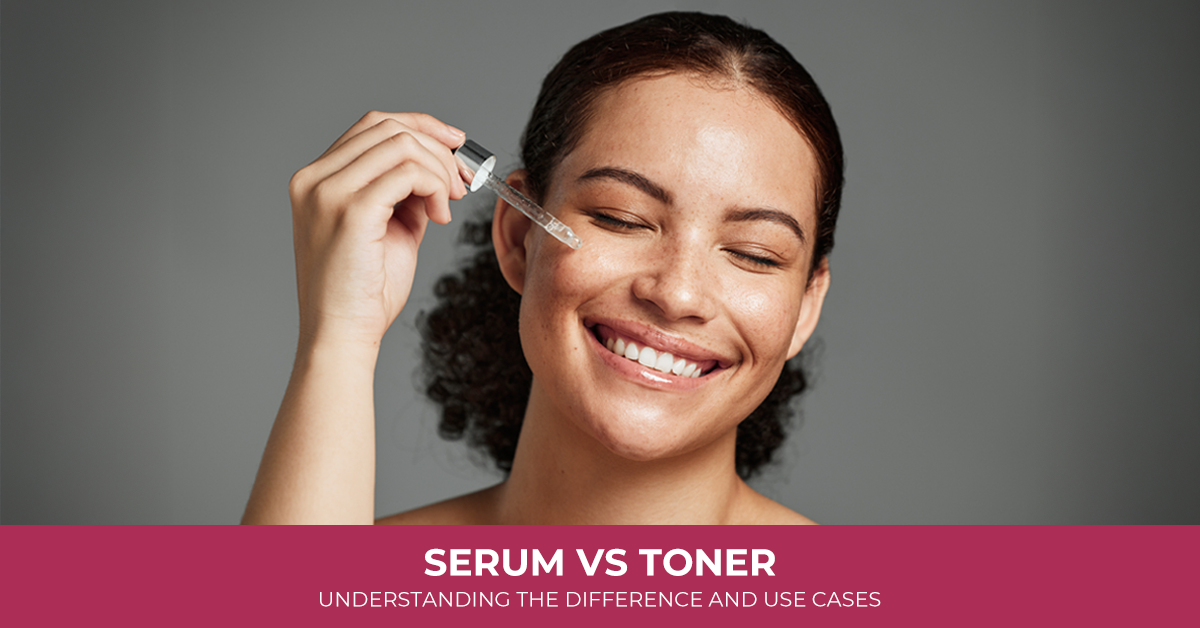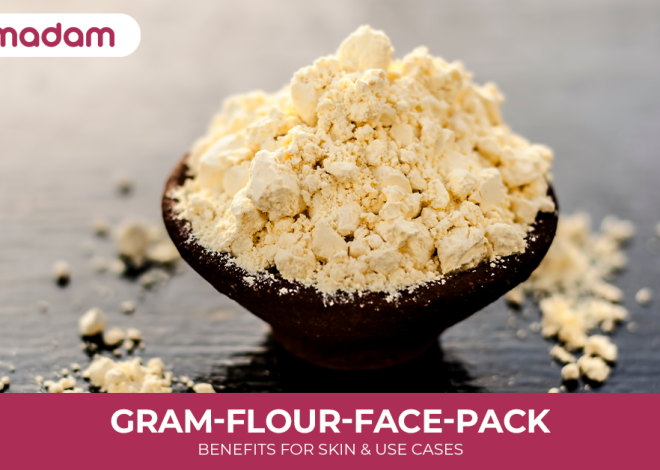
Serum vs Toner: Understanding the Difference and Use Cases
In the vast, evolving skincare world, people use multiple products in their daily routines. Among these, serum and toner are two popular add-ons used after cleansing and before moisturizing. When it comes to serum vs toner, knowing their differences can enhance your skincare routine.
A basic skincare routine follows three simple steps: cleanser, serum, and moisturizer. Some people use toner after cleansing or even replace the serum step with it.
Both toner and serum play important roles. Understanding the difference between serum and toner will help you maximize their benefits by correctly incorporating them into your skincare routine.
Table of Contents
What Is a Face Toner?
Skin toners, or facial toners, are skincare products designed to cleanse pores by exfoliating dead skin cells, effectively continuing the work started by your cleanser.
Applied after cleansing, toners balance the skin’s pH level, remove residual impurities, and prepare the skin for better absorption of the products that follow.
What Is a Face Serum?
Serums are usually water-based products packed with high concentrations of active ingredients to address various skin problems and suit different skin types. A serum’s ingredients are formulated to penetrate the epidermis, the upper layer of the skin, easily. They target specific skin concerns such as hydration, brightening, or anti-aging.
Toner vs. Serum: How They Differ and Why It Matters
Serums are concentrated treatments targeting specific skin issues, while toners balance pH and cleanse. There is a significant difference between serum and toner, as they both differ in various ways. Using both enhances absorption and effectiveness, improving overall skin health. The serum vs. toner debate mainly revolves around their textures and roles in a skincare routine.
The primary differences are listed below in the table and will help you understand them better.
More Information For You: best skincare products for dry skin
| Aspect | Serum | Toner |
| Texture | Gel, water-based, or lightly creamy. | Liquid skincare product. |
| Usage | Applied after toner and before moisturizer. | Applied after cleansing your skin. |
| Key Ingredients | Vitamin C, Retinol, Niacinamide etc | Witch hazel, tea tree, vitamin C, etc. |
| Skin Concerns | Wrinkles, acne, dark spots, and more. | Enlarged pores, dry patches, or fine lines. |
| Primary Functions | Balances PH, hydrates, and eliminates impurities. | Treats specific skin problems, and hydrates. |
| Packaging | Available in small bottles. | Sold in larger bottles. |
Recommended You: Korean Beauty Secret
Do I Need a Serum or Toner in my Skincare Routine?
Wondering whether to use a toner, serum, or both? Understanding their benefits can help you decide and settle the debate over toner vs. serum. Toners balance pH, remove impurities, and prep the skin for better absorption. Serums deliver concentrated active ingredients to target specific concerns like wrinkles, hydration, or dark spots. Using both enhances effectiveness, but your choice depends on your skin’s needs and goals.
Benefits of Adding Toner to Your Skincare Routine
Toner is the perfect post-cleanse refresh for your face. It enhances skin texture with the following benefits:
- Infuses Skin with Nutrients: As a liquid-based product, toner acts as a second cleanse, delivering essential nutrients to the skin.
- Balances pH Levels: Harsh cleansers can be alkaline, disrupting your skin’s pH. Toners with soothing and hydrating ingredients restore balance.
- Brightens Skin Tone: Environmental stressors can dull your complexion. Toners revive your skin’s natural glow.
- Minimizes Enlarged Pores: Toners unclog pores, removing dead skin cells, dirt, makeup, and excess oil for a smoother appearance.
- Boosts Hydration: They provide quick hydration, enhancing the skin’s ability to absorb other skincare products effectively.
Recommended Reading: Skincare Products For Oily Skin
Benefits of Using Serum on Your Face
Serum is a concentrated skincare product that delivers intense hydration and addresses various skin concerns, offering the following benefits:
- Deep Hydration: Serums provide intense hydration, combating dryness and dehydration.
- Reduces Dark Spots and Blemishes: Vitamin C serums help fade dark spots, blemishes, and even hyperpigmentation.
- Anti-Inflammatory Properties: Serums soothe irritation and reduce inflammation, especially for dry or sensitive skin.
- Reduces Fine Lines and Wrinkles: Ingredients like retinol and niacinamide minimize visible signs of aging, such as fine lines and wrinkles.
- Quick Absorption: Lightweight and fast-absorbing, serums are ideal for layering in your skinkcare routine.
- Minimizes Pores: Serums exfoliate, promote cell turnover, and control excess oil, helping to reduce pore size.
How Long Should You Wait to Apply Serum After Toner?
There is no need to wait before applying serum after toner. Experts suggest applying serum immediately, as it absorbs better when the skin is prepped with toner.
Key Points to Remember:
- No Wait Time Needed: For best results, apply serum right after toner on slightly damp skin.
- Quick Absorption: Serums are designed to penetrate quickly, so delaying application isn’t necessary.
- Skin Type Considerations: If you have very oily skin, waiting a few seconds for the toner to settle might be beneficial before applying serum.
Don’t Miss: Types of Hair Extensions
Conclusion
Toners and serums are essential skincare products with unique functions. Understanding the difference between toner and serum helps you incorporate them effectively into your routine based on your skincare goals. While both are valuable, they serve different purposes and are not interchangeable.
If you had to choose between toner and serum, serum offers more targeted benefits, addressing specific skin concerns like fine lines, pigmentation, and dullness. However, using both together maximizes results by hydrating, nourishing, and protecting your skin.
FAQs
Is vitamin C better as a serum or toner?
Vitamin C is better as a serum because it is formulated to penetrate the skin’s surface more effectively than a toner or heavier products.
Can I use serum without toner?
Yes, you can use a serum without a toner as long as you thoroughly cleanse your face first. While toner helps remove residual impurities and enhances serum absorption, it is not mandatory in a skincare routine.
Is niacinamide better as a toner or serum?
A niacinamide serum is generally better as it contains a higher concentration of niacinamide compared to a toner.
Can I skip serum after toner?
Yes, you can skip serum after toner, but it is generally recommended to apply a serum for more concentrated active ingredients and better skin penetration.
How long should toner sit before serum?
Experts suggest waiting between 30 seconds and 15 minutes before applying serum. However, applying products immediately after each other won’t harm the skin.
Toner or serum which is better
Serum is generally considered better than toner for targeting specific skin issues and deeper skin penetration.
What comes first, serum or toner?
Toner comes first because it prepares the skin by balancing its pH level and removing remaining impurities.
Is toner really necessary before serum?
Toner is not necessary for everyone. It is useful for balancing pH and prepping the skin, but those with clear, non-oily skin might not need it.
Is it ok to use serum without toner?
Yes, it is okay to apply serum without toner as long as your face is freshly cleansed. Improper cleansing can hinder serum absorption.
What is the difference between facial toner and serum?
Toners balance the skin’s pH and remove impurities, while serums are formulated to target specific skin concerns with active ingredients.



